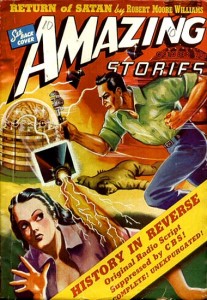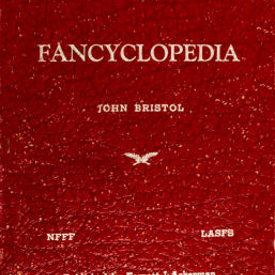
Originally published under the title “The Priestess Who Rebelled” in the October 1939 issue of Amazing Stories, author Nelson S. Bond’s speculative account is a story of sexual dominance in a future gone astray. Also turning up under the title Pilgrimage (as reviewed here from the 1969 The Best of Amazing anthology with selections by Joseph Ross), this compelling story of sexual inequality is actually a wonderful example of artistic allusion and the dangers of recording historical accounts.
I should warn readers that this review contains spoilers of a sort. But it should also be pointed out that after reading it the first time and the cat-is-out-of-the-bag, the true pleasure in the story comes from subsequent readings as the reader looks for all of the hidden clues Bond has left us.
The story begins by following Meg, a young woman about to enter the age of adulthood where according to Law, she is to decide what “station” in life she will chose. It is not her fault that her options are so limited. In this society of female domination where the men’s rolls are that of servants, the women have fallen to a lackadaisical view of responsibility. To make matters worse, Meg does not care for the three choices: warrior, worker, or a breeding mother.
After entering the hoam of the Mother of the Clan, she discovers the old woman wielding a magic stick. It appears to be a strange kind of witchcraft, a secret ritual only the Mother knows about. After dipping it in a dish, the Mother “scratched upon a smooth, bleached, calf-skin scroll.” Bewildered, Meg asks the old woman what this magic is.
Having experienced my own curious children asking what I was doing while clicking away at this keypad, I couldn’t help but appreciate the Mother’s response to Megs question. “It is ‘writing,’ Meg. Speech without words.” Though I will forever use this quote in the most sarcastic manner possible whenever my kids continue to ask me what I am doing, Meg took the response with a lot more awe. But even as my kids roll their eyes and walk away, I have to admit, this writing thing truly is truly.
The Mother is responsible for keeping historic records, including the “books” from ages past written by the Ancient Ones. Meg is transfixed by this new discovery. Reading? Writing? Considering the old woman’s declining health, Meg shuns the three standard choices of stations and declares that she wants to become the new Mother of the Clan and the old woman agrees. After a long period of studying the magic of words and the multiplication and subtractions of numbers, Meg must face one final test.

Meg uses a map (“a teller-of-places”) to journey far away, across dangers lands of the Wild Ones (rogue clans of men) to the Place of the Gods. Here, she will learn the final secret of the four strong female deities: “the Great Four. Stern Jarg and mighty Taamuz, with ringletted curls framing their stern, judicial faces; sad Ibrim, lean of cheek and hollow of eyes; far-seeing Tedhi, whose eyes were concealed behind the giant telescopes; whose lips, even now, were peeled back as though to loose the dreadful laughter.” It is a truth kept from the Clan for many generations.
Pilgrimage (or The Priestess Who Rebelled, whichever title you prefer because they both fit nicely) by Nelson S. Bond is a brilliant illustration of creative allusion. From the deceivingly twisting of lyrics to historical songs to the persuasive confusion instilled by generations of word-of-mouth lore, it makes one wonder about the mark we leave on society today and how it will be perceived tomorrow.










